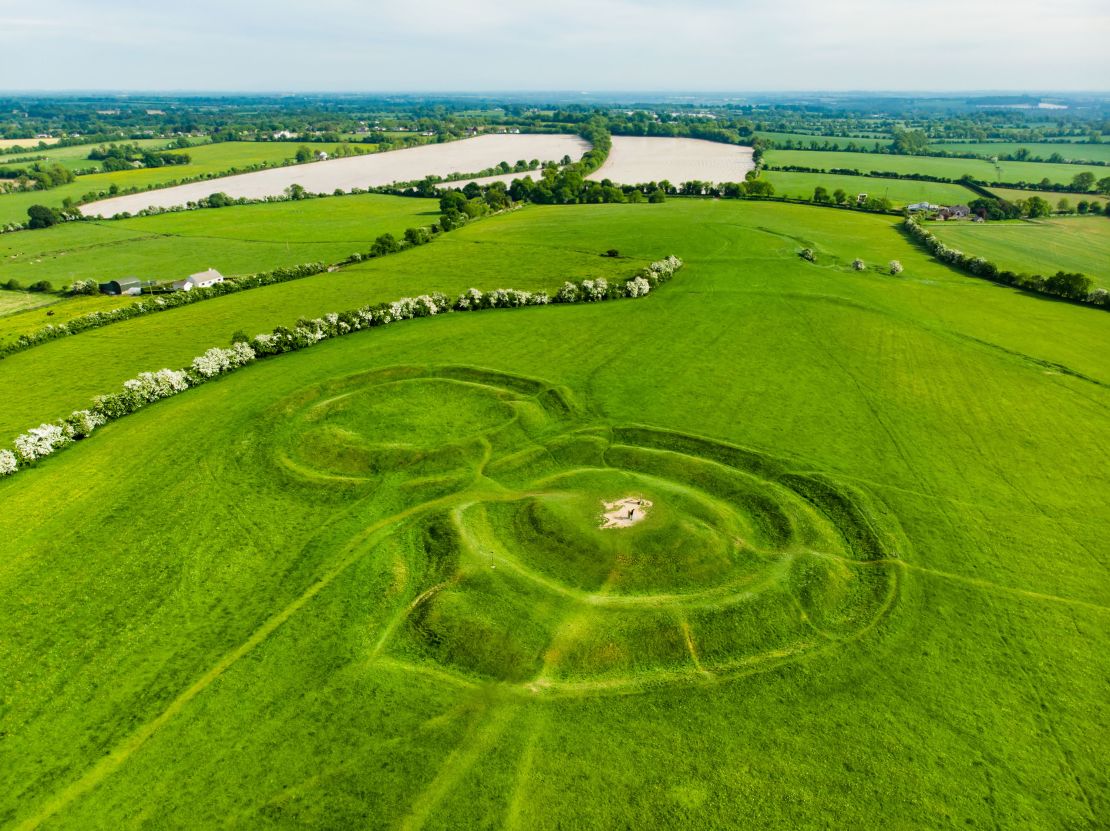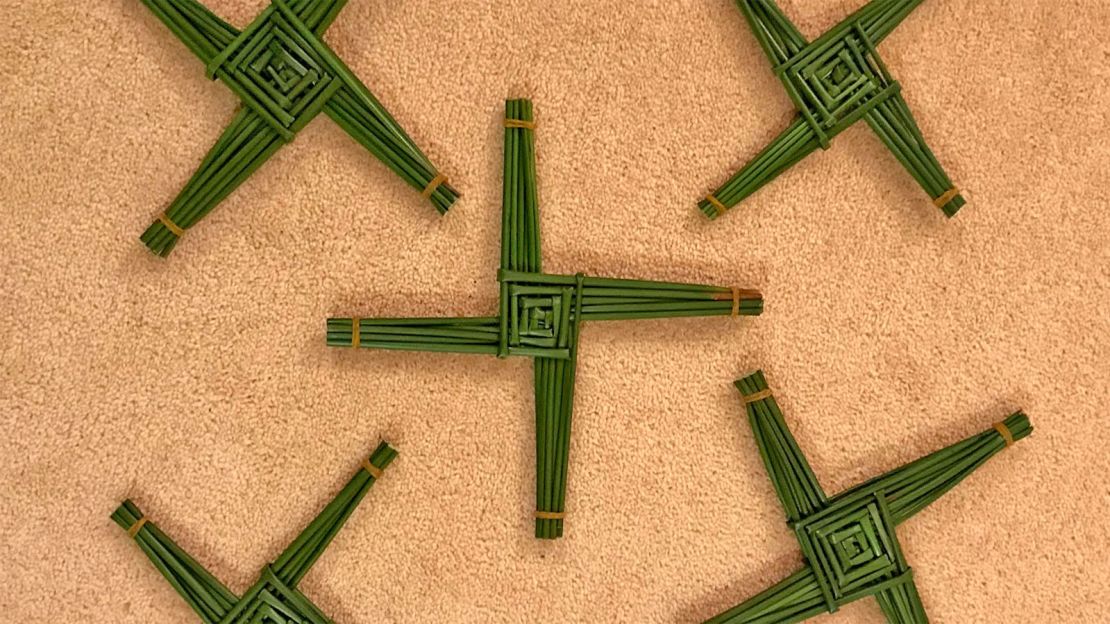On forgotten walls of country churches or crumbling castles throughout Ireland, the tiny figures squat unseen.
Lost in gray brickwork, obscured by ivy or moss, Sheela-na-gig stone carvings can be hard to spot in the wild – but these medieval creations are in no way coy.
Typically bald-headed naked females, with hanging breasts and legs spread wide to display exaggerated vulvas, Sheela-na-gigs at first seem peculiarly out of place in the prim surroundings of a Christian church.
However, these envoys from an ancient past have a lot to teach us about Irish and northern European history, and about the pagan roots of the global festival now known as St. Patrick’s Day.
While in modern times it’s a one-day celebration, it was once a three-day carnival that finished on March 18 – Sheelah’s Day.
This is the story of Sheelah – who she was, why she was forgotten when St. Patrick was not, and what traces of her are left behind.
‘She’s always there’
Irish mythology is peopled with many female figures. Tales of warrior queens, deities, kingmakers and sacred hags have been passed down from generation to generation.
However, an oral folk tradition means that names, characters and meanings morph over time – and are subject to the interpretative whims of changing societies.
“Sheelah is one folk manifestation of what we call female cosmic agency,” says Shane Lehane, an archaeologist, folklorist and historian at Cork’s CSN College of Further Education who has been instrumental in reviving interest in Sheelah in recent years.
“Think of her as the consort of the male, that great mythological tradition of the king and the goddess. She represents the land.”
While Sheela-na-gigs are medieval, and the figure of Sheelah first appears in newspaper and documentary accounts around the 17th century, tracing her history back to what is believed to be her ancient Celtic beginnings is a near-impossible task.
“There is a body of belief amongst people who study mythology that every female figure in some shape or form represents this entity,” says Lehane. “The very fact she survives is interesting. She’s always there.”
‘That great human concern’
There are Sheela-na-gig carvings around northern Europe – one of the finest examples is at Kilpeck Church in Herefordshire, England – but there are 115 listed nationally in Ireland, more than anywhere else in the world.
As they’ve often been shifted from their original locations and placed in new buildings, “it’s quite hard to date them, but the consensus is that they date between the 12th and the 15th or 16th century,” says Matt Seaver, assistant keeper at the National Museum of Ireland. The museum has one Sheela on display at its Dublin archeology museum while six more are on loan to regional exhibitions.
There are two main competing interpretations of Sheelas, explains Seaver. The older view is that they’re “promoting chaste living, a taboo on sexuality in the Middle Ages. The other theory that’s developed, primarily since the 1930s, sees them as symbols of fertility.”
Lehane, one of these revisionists, tells CNN Travel that, “Sheelah has been the subject of a strong misogynistic perspective for a long time. They were seen as being symbols of evil, symbols of lust, symbols of eroticism.”
He argues that Sheela-na-gigs celebrate “the female who has custodianship over birth and over death. Sheelah is an icon of that great human concern.”
Embrace the hag

The Hill of Tara in County Meath is the ancient seat of Ireland’s High Kings, a site for ceremony and burial that has been in use for more than 5,000 years. Tour buses travel north from Dublin to visit Tara and nearby Newgrange, a Stone Age passage tomb.
Tara’s Lia Fáil, a phallus-like standing stone, has a potent history, explains Lehane. “If you were going to be king you sat up on top of the Lia Fáil and you symbolically mated with the land. If you were the right king, the Lia Fáil would screech.”
There are many examples in Celtic mythology of what are termed sovereignty goddesses – female deities who bestow kingly powers through copulation.
When a king falls out of line, the goddess who represents the land transforms into a withered old woman, similar to the Sheela-na-gig, known as the Cailleach. “For the new king to come along, he must embrace this dangerous hag,” says Lehane, “and she reforms into this beautiful, bountiful, kind figure again.”
The Cailleach is found wherever land is barren and treacherous, and weather unforgiving. She’s given her name to megalithic tomb, rocks at seas, and mountainous outcrops. You can come face to face with the Cailleach at the Ceann na Caillí (Hag’s Head) at the Cliffs of Moher and the passage tomb atop Slieve Gullion mountain known locally as Calliagh Beara’s House.
‘The first story of Ireland’
St. Patrick, the historical figure, was a former slave trafficked into Ireland from Roman Britain in the fifth century. Exclusively among the Irish saints, he wrote down his own story, in two Latin works “Confessio” and “Epistola.”
“The one thing that very few people disagree about is that there was someone called Patrick and he wrote what became the first story of Ireland,” says Tim Campbell, director of the Saint Patrick Centre in Downpatrick, County Down. “The history of Ireland literally begins with him.”
Patrick makes reference to more earthy Celtic tradition when he writes of refusing to show subjugation to another man by sucking his nipples. There are two preserved Iron Age bodies on display in the National Museum of Ireland that are testament to this. They belong to two failed kings who have been ritually killed and their nipples cut off, so that no one may pledge fealty.
Patrick’s legacy as a Christian missionary and bishop “was woven into the later legends of early medieval Ireland,” says Campbell, and the mythical Patrick would absorb the older legends too.
‘Embrace chaos’
The god Lugh is the one most associated with kingship in Ireland, says Lehane. “He represents the perfect male.”
When Christianity came along, the legend of Patrick took over the cult of Lugh. And at his side there was his consort, Sheelah – who was now referred to as Patrick’s wife.
Many countries have pre-Christian springtime festivals and Ireland is no different. The three-day celebration of Patrick and Sheelah – from March 16 to 18 – falls just before the spring equinox. The license to cavort and disregard the strictures of Lent is Ireland’s version of Carnival.
“You were expected to go wild, to throw caution to the wind, to embrace chaos, because that’s the nature of Carnival,” says Lehane. “It’s a very important Irish tradition to recognize.”
Christian influence tamed the festival’s licentiousness and Sheelah’s Day – recorded as being widely celebrated by the Irish and Irish diaspora in the 18th and the 19th century – fell to the wayside. But Patrick was not left without a female companion.
Three saints, one grave
Patrick may be the poster boy, but Ireland has two other patron saints – Saint Brigid and Saint Colmcille. All three, thanks to the impressive promotional efforts of Anglo-Norman knight John de Courcy, are reputed to be buried under the same rock in Downpatrick, a holy site to this day.
“During the medieval period, everywhere was claiming to be a place of pilgrimage. If you could get the three major Irish saints all buried in the one place, you’d won the lottery,” laughs Lehane.
The Christian Saint Brigid shares many attributes of the pre-Christian goddess Brigid and the saint’s feast day – February 1 – was originally the pagan festival of Imbolc, marking the first day of spring. From 2023, St Brigid’s Day will be Ireland’s newest national holiday.
Irish people still celebrate this springtime festival by weaving St. Brigid’s crosses, made from rushes, to set over doorways and windows to protect the home from harm.

Holy wells
Saint Patrick, and Brigid too, are associated with Ireland’s holy wells, of which there are thousands. These natural springs, reserved for curative purposes, are found “in practically every parish,” says Lehane.
Women would repair to holy wells for relief from gynecological problems, to pray for the protection of their virginity or to promote fertility. And while Patrick is the wells’ most famous patron, “the majority of the wells are dedicated to female figures,” says Lehane.
“If the waters have sulfur in them, that’s good for skin conditions; if they contain magnesium that’s good for muscle function and the heart; if the well is iron-rich that’s good for people who are anaemic,” Celeste Ray, an American academic who is compiling a database mapping the sites of all Ireland’s holy wells, recently told the BBC.
Today, the few surviving Sheela-na-gigs can often be found near holy wells, while wells will also commonly have a rag tree, upon which visitors have fixed their tokens and their prayers.
“The Sheela-na-gigs represent a point between life and death,” says Lehane. During the many centuries when pregnancy was a delicate balance between a fruitful new beginning or a young life cut short, women turned to Sheelah – an icon of birth – in their time of need.
The wells too provided a female space of sanctuary and healing in a sometimes hostile landscape.
Sheelah, the earth goddess, lives on in these quiet pockets of rural Ireland, where water flows below and the wind ruffles the grassy hills and the ribbons in the rag trees.
In Irish mythology, the hag is withered, but she is also ageless. She’ll outlive us all.
Digital Heritage Age’s Sheela-na-gig 3D project has created 3D digital models of the Sheelas in the National Museum of Ireland’s collection. All the holy wells mapped in the Republic of Ireland are here and Ireland’s sheela-na-gigs have been mapped by heritagemaps.ie.











